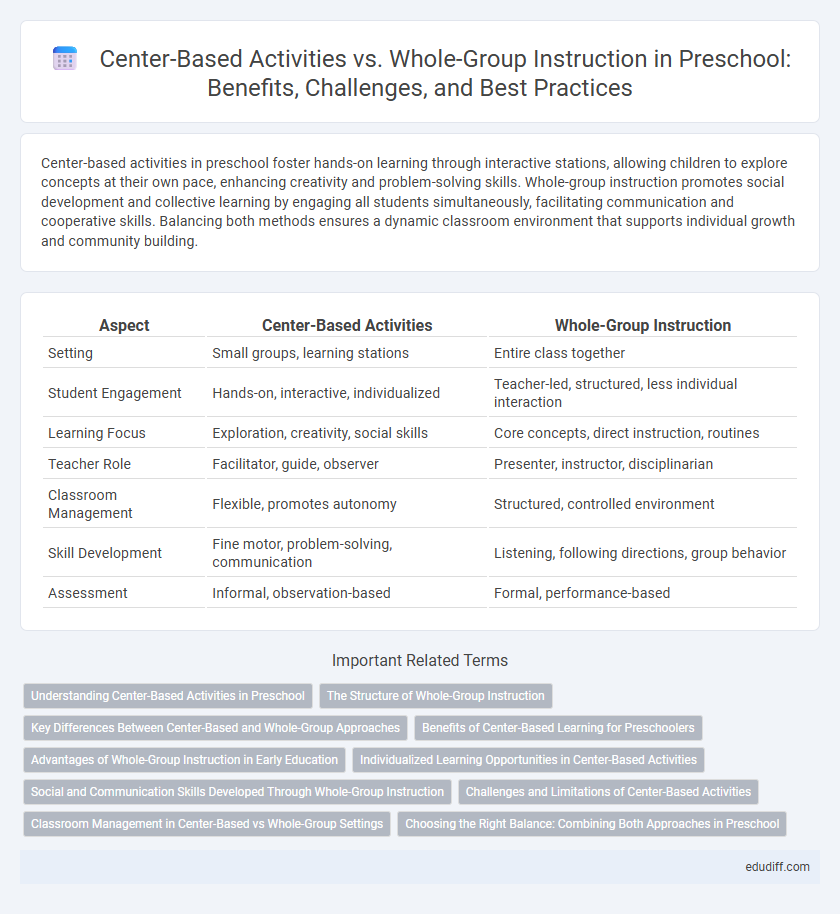Center-based activities in preschool foster hands-on learning through interactive stations, allowing children to explore concepts at their own pace, enhancing creativity and problem-solving skills. Whole-group instruction promotes social development and collective learning by engaging all students simultaneously, facilitating communication and cooperative skills. Balancing both methods ensures a dynamic classroom environment that supports individual growth and community building.
Table of Comparison
| Aspect | Center-Based Activities | Whole-Group Instruction |
|---|---|---|
| Setting | Small groups, learning stations | Entire class together |
| Student Engagement | Hands-on, interactive, individualized | Teacher-led, structured, less individual interaction |
| Learning Focus | Exploration, creativity, social skills | Core concepts, direct instruction, routines |
| Teacher Role | Facilitator, guide, observer | Presenter, instructor, disciplinarian |
| Classroom Management | Flexible, promotes autonomy | Structured, controlled environment |
| Skill Development | Fine motor, problem-solving, communication | Listening, following directions, group behavior |
| Assessment | Informal, observation-based | Formal, performance-based |
Understanding Center-Based Activities in Preschool
Center-based activities in preschool emphasize hands-on learning through exploration, fostering cognitive, social, and fine motor skills development within small groups or individually. These activities promote self-directed engagement and creativity, allowing children to learn at their own pace, contrasting with the structured, teacher-led whole-group instruction format. Research shows that center-based learning enhances problem-solving abilities and peer collaboration, making it an essential component of effective early childhood education.
The Structure of Whole-Group Instruction
Whole-group instruction in preschool involves a structured routine where the teacher guides all children simultaneously through planned activities, fostering shared learning experiences. This approach emphasizes clear organization, consistent timing, and interactive dialogue to maintain engagement and support social development. The predictable structure helps young learners develop listening skills and group participation essential for early education success.
Key Differences Between Center-Based and Whole-Group Approaches
Center-based activities promote hands-on learning through small groups, fostering individualized attention and social interaction, while whole-group instruction emphasizes teacher-led lessons targeting uniform skill development. The center-based approach encourages exploration and self-paced learning, enhancing critical thinking and collaboration, whereas whole-group settings streamline content delivery and classroom management. Both methods address diverse learning needs but differ in engagement style, pacing, and interaction dynamics within early childhood education.
Benefits of Center-Based Learning for Preschoolers
Center-based activities in preschool promote hands-on learning, encouraging creativity and social interaction among children. These learning centers enable individualized pacing, allowing preschoolers to explore concepts deeply and develop critical thinking skills. Unlike whole-group instruction, center-based learning fosters independence and collaboration, leading to improved cognitive and emotional development.
Advantages of Whole-Group Instruction in Early Education
Whole-group instruction in early education fosters social interaction and collaborative learning by engaging all children simultaneously, promoting language development and collective problem-solving skills. This method ensures consistent delivery of curriculum content, allowing teachers to address the entire class efficiently while reinforcing shared norms and behaviors. Research from the National Association for the Education of Young Children (NAEYC) highlights improved communication and peer bonding as key advantages of whole-group settings over isolated, center-based activities.
Individualized Learning Opportunities in Center-Based Activities
Center-based activities in preschool create individualized learning opportunities by allowing children to explore tasks at their own pace, tailored to their developmental needs and interests. This approach fosters autonomy and creativity, enabling targeted skill development through hands-on experiences. In contrast, whole-group instruction often follows a uniform pace, limiting differentiation and personalized engagement.
Social and Communication Skills Developed Through Whole-Group Instruction
Whole-group instruction in preschool settings fosters social and communication skills by encouraging cooperative learning, turn-taking, and active listening among children. It creates a structured environment where peers engage in shared conversations, enhancing vocabulary development and pragmatic language use. Center-based activities complement this by allowing individualized practice, but whole-group settings uniquely promote collective dialogue and social interaction.
Challenges and Limitations of Center-Based Activities
Center-based activities in preschool often present challenges such as managing diverse skill levels and maintaining engagement without constant adult supervision, which can lead to inconsistent learning outcomes. Limited space and resources in each center may restrict the variety and depth of activities, reducing opportunities for comprehensive skill development. Unlike whole-group instruction, center-based activities can hinder uniform assessment and pose difficulties in ensuring that all children receive equal attention and support from educators.
Classroom Management in Center-Based vs Whole-Group Settings
Center-based activities promote individualized learning and foster student autonomy, requiring teachers to manage multiple small groups simultaneously while facilitating exploration and engagement. Whole-group instruction demands more structured classroom management techniques to maintain attention and order, as the teacher directs activities for all students at once. Effective classroom management in both settings hinges on clear routines, consistent expectations, and adaptive strategies tailored to group size and activity type.
Choosing the Right Balance: Combining Both Approaches in Preschool
Center-based activities foster individualized learning through hands-on exploration, promoting autonomy and social skills in preschoolers. Whole-group instruction supports structured skill development and reinforces shared concepts, facilitating classroom cohesion and collective engagement. Balancing these approaches enhances cognitive growth, accommodates diverse learning styles, and creates a dynamic, inclusive preschool environment.
Center-based activities vs Whole-group instruction Infographic

 edudiff.com
edudiff.com